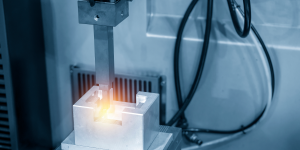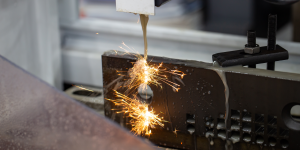La précision et l'adaptabilité de l'usinage de décharge électrique (EDM) Faire des activités de fabrication d'aujourd'hui. Ce processus implique l'éjection de matériau d'une pièce par le biais de décharge électrique afin de produire des conceptions et des formes complexes. Nous allons discuter de sept façons d'utiliser EDM et vous fournir les meilleurs conseils pour utiliser pleinement cette technologie contemporaine.
1. Qu'est-ce que l'usinage à décharge électrique (EDM) Et comment ça marche?
Les étincelles électriques de broyage d'un matériau d'une pièce dans l'usinage à décharge électrique sont une procédure de fabrication précise. Il est appliqué en aérospatial, automobile, et les industries médicales pour produire des formes complexes. Dans le processus, La pièce et l'outil ou l'électrode sont des électrodes. Les deux électrodes créent un arc contrôlé qui érode la pièce.
Aussi, La chaleur de l'électrode étincelle fond et vaporise les matériaux du liquide diélectrique rincer. Malgré le fait que l'acier durci et les alliages étranges sont difficiles à mouiller, EDM fonctionne bien. Ses forces sont de haute précision, bonne qualité de surface et formes compliquées avec des tolérances serrées. De nombreux secteurs dépendent de l'EDM, un processus de production polyvalent et efficace.
2. Comment utiliser EDM pour créer des formes complexes?
Usinage à décharge électrique (EDM) peut fabriquer avec précision et précisément des formes complexes. EDM utilise des étincelles électriques pour dissoudre le matériau et créer des formes détaillées que l'usinage régulier ne peut pas. Une génération d'étincelles de fluide diélectrique et une électrode en cuivre ou en graphite est utilisée.

Les étincelles entre l'électrode et la pièce forment de minuscules cratères qui érodent et façonnent le matériau. Aérospatial, automobile, et les industries des dispositifs médicaux peuvent utiliser cette approche pour créer des formes compliquées. EDM travaille sur des aciers durcis, titane, et alliages exotiques. EDM permet des formes compliquées dans la conception et fabrication, Pousser les limites d'ingénierie.
3. Quels sont les avantages de l'utilisation d'EDM pour l'outil et la création?
Usinage à décharge électrique (EDM) pour la fabrication d'outils et de matrices présente de nombreux avantages. Avant tout, EDM peut créer des formes détaillées et sophistiquées que l'usinage régulier ne peut pas. Parce que EDM utilise des étincelles électriques pour dégrader le matériau, cela fait des incisions précises. EDM peut fonctionner avec des aciers durcis et des alliages exotiques, un autre avantage.
EDM coupe sans toucher la pièce, abaisser la possibilité de distorsion ou de dommages. EDM peut générer précisément petit, Caractéristiques délicates comme les coins pointus ou les détails subtils. EDM produit des résultats fiables et réduit les ajustements manuels et les retravailleurs car il est reproductible. EDM est utile pour la production d'outils et de matrices en raison de ses nombreux avantages.
4. Comment utiliser EDM pour la production de prototypes?
EDM (Musique de danse électronique) Les concepts doivent être compris pour utiliser ce genre pour créer des prototypes. EDM comprend une maison, techno, et dubstep et se développe toujours. Les fans de musique du monde aiment ses rythmes accrocheurs et ses mélodies complexes. Le potentiel d'EDM va au-delà du divertissement. Cela peut stimuler le prototypage.
Les composants rythmiques d'EDM et les textures auditives permettent aux concepteurs et aux ingénieurs de créer des prototypes fonctionnels qui engagent les utilisateurs sensoriellement. Les lignes de basse lancinantes et les mélodies synthétisées extatiques peuvent encourager la créativité et défier les normes de conception. L'énergie et la complexité d'EDM peuvent être transférées dans des prototypes physiques qui sont surprenants et innovants. La prochaine fois que vous prototype, Considérez comment l'EDM peut déclencher l'invention.
5. Quel rôle joue l'EDM dans l'industrie aérospatiale?
EDM, ou usinage à décharge électrique, est vital pour l'aérospatiale. Cette méthode d'usinage innovante utilise des étincelles électriques pour dégrader les matériaux pour des coupes précises. L'EDM est largement utilisé dans l'aérospatiale pour fabriquer des composants et des moules complexes pour les moteurs et structures d'aéronefs. Cette technologie permet aux producteurs de faire avec précision et de manière répétée des formes et des conceptions complexes.

L'EDM est utile dans l'aérospatiale car il peut traiter le titane et les alliages de nickel. Les entreprises aérospatiales peuvent rendre légers, composants robustes, Amélioration de l'efficacité énergétique et des performances des avions. EDM prolonge également la durée de vie des pièces d'aéronef importantes par réparation et entretien. En conclusion, EDM aide l'industrie aérospatiale à créer des composants complexes, Améliorer les performances, et assurer la sécurité et la fiabilité des avions.
6. Comment utiliser EDM dans le domaine médical?
Musique de danse électronique (EDM) va au-delà des fêtes et des divertissements. C'est un puissant outil thérapeutique et de traitement en médecine. L'EDM réduit la tension et l'anxiété chez les patients en stimulant le cerveau et en se détendant avec ses battements palpitants et ses modèles rythmiques.
EDM est également utilisé dans les systèmes de réalité virtuelle, Permettre aux patients de subir un traitement dans un monde virtuel. Cette nouvelle stratégie améliore l'efficacité de la thérapie et l'engagement des patients. EDM est une avenue de recherche médicale prometteuse en raison de son adaptabilité et de ses avantages potentiels.
7. Quelles sont les applications de l'EDM dans l'industrie électronique?
L'industrie électronique utilise une décharge électrique usinage (EDM), Une technologie de production polyvalente. Ses nombreuses utilisations le rendent essentiel pour les composants électroniques. EDM est utilisé pour fabriquer des moules de dispositifs électroniques compliqués. La précision et la précision d'EDM permettent des motifs et des conceptions de surface de moule compliqués, Assurer la fonctionnalité des composants électroniques.
EDM fabrique également des microélectrodes pour les circuits intégrés et les micropuces. L'EDM est idéal pour miniaturiser les composants électriques en raison de sa précision. En plus, EDM est utilisé pour établir des connexions, capteurs, et d'autres éléments électroniques importants. EDM a plusieurs utilisations dans le secteur de l'électronique et aide à fabriquer des gadgets de haute qualité.
Conclusion
L'usinage de décharge électrique est une technique merveilleuse avec des applications industrielles incroyables. EDM offre une précision et une polyvalence que les technologies d'usinage traditionnelles ne peuvent pas correspondre lors de la création de géométries complexes, prototypes, ou composants cruciaux. La fabrication peut atteindre de nouveaux sommets de créativité et de production avec EDM. Alors pourquoi retarder? Entrez EDM et découvrez son potentiel illimité!
